牛津译林版高中英语选修模块七 模块七第四单元Project教案-新版
牛津译林版高中英语选修模块七 模块七第四单元Word power教案-新版
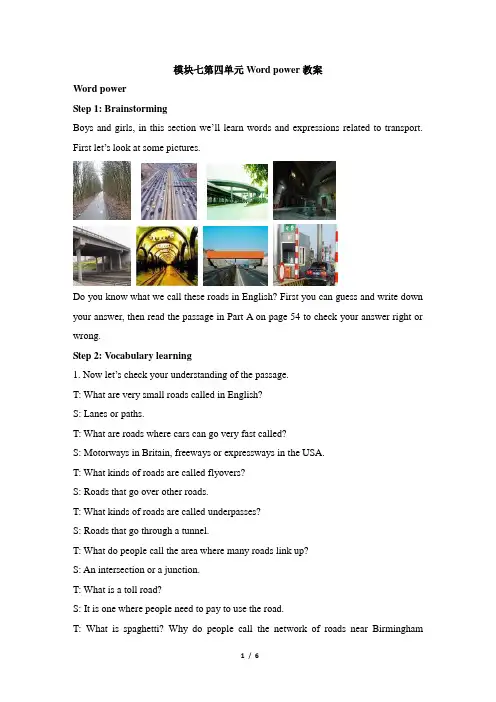
模块七第四单元Word power教案Word powerStep 1: BrainstormingBoys and girls, in this section we’ll learn words and expressions related to transport. First let’s look at some pictures.Do you know what we call these roads in English? First you can guess and write down your answer, then read the passage in Part A on page 54 to check your answer right or wrong.Step 2: Vocabulary learning1. Now let’s check your understanding of the passage.T: What are very small roads called in English?S: Lanes or paths.T: What are roads where cars can go very fast called?S: Motorways in Britain, freeways or expressways in the USA.T: What kinds of roads are called flyovers?S: Roads that go over other roads.T: What kinds of roads are called underpasses?S: Roads that go through a tunnel.T: What do people call the area where many roads link up?S: An intersection or a junction.T: What is a toll road?S: It is one where people need to pay to use the road.T: What is spaghetti? Why do people call the network of roads near Birmingham“Spaghetti Junction”?S: Spaghetti is a kind of noodles in the shape of long thin sticks. The network of roads near Birmingham is made up of many intersections and flyovers, which looks like strings of spaghetti.T: What is a street?S: A road with sidewalks in a city or town.T: What is an avenue?S: A wide road lined with trees on each side.T: What is called a way?S: A passage from one place to another.2. Part B.Well done, everyone! Now let’s come to Part B. Zhao Ning has categorized the different ways that we can travel in a flow chart. Look at the chart she has made. Make sure you know the meaning of each word. After you finish reading, I’ll ask you some questions.Who has ever traveled by light railway or underground? What was it like? Do you like traveling by light railway or underground? Why or why not?Have you ever traveled by coach/ by aeroplane/ by ferry/ by ship? How do you like it? If you are traveling to Nanjing, what means of transport will you choose?If you want to go London, which means is the best choice?3. Part CRead the passage in Part C, which is an introduction to a transport project. You should complete the introduction with the words you’ve learnt in Parts A and B. Several minutes later, I’ll check your answers.Step 3: vocabulary extensionDo you know any other words or phrases related to transport besides what you have already learnt in Part A and B? For Example:T: What must we do before we go somewhere by train or by plane?S: We must book a ticket beforehand.T: Where will you go to buy the ticket?S: The ticket office.T: What must we do before we get on the train or plane?S: Make clear about your train or plane number and your seat number.T: Before we get off, what shall we do?S: We must make clear about our destination and take all the package with us.T: What do we call the person who is traveling by train or plane?S: passenger.T: What do we call the person who sells bus ticket?S: A conductor.T: If you want to travel to a foreign country, what must you have?S: A passport.Good. You know these things very well. Now let’s come to Part D and fill in the box. You can present more words and phrases related to the correct categories.Step 4: Consolidation exercises:1. Match the words related to transport in Column I with their definitions in Column II.I II1) lane ______ a a boat or ship for taking passengers and often vehicles across an area of water, especially as a regular service2) coach ______ b a public road, especially an important road that joinscities or towns together.3) ferry ______ c a vehicle designed for air travel, which has wings andone or more engines4) underground ______ d a road or path that goes under something such as abusy road, allowing vehicles or people to go from one side to the other5) flyover ______ e a bridge that carries a road or railway over anotherroad.6) railway ______ f a place where things, especially roads or railways, come together7) highway ______ g a narrow road in the countryside or in a town.8) underpass ______ h a long motor vehicle with comfortable seats, used to take groups of people on journeys9) junction ______ i the metal tracks on which trains run.10) aeroplane ______ j a railway system in which electric trains travel alongpassages below ground.2. Complete the sentences with proper words or phrases in the box below. Changes the form where necessary.1) Americans usually say “____________”, but British people say “motorways”.2) It is so exciting to drive a ____________ on the lake.3) He is a kind ____________ and he always gives his passengers help in time.4) Many people are eager to go to the concert, so you’d better ____________.5) Annie is going to Shanghai to visit her uncle and she’ll stay there for three weeks. So she just bought a ____________.6) Many years ago, when people were traveling on the underground, they could never imagine there would be ____________.7) It’s a ____________. You need to pay some money to pass.8) Many refugees(难民) have arrived at the border without ____________.9) If you want to be back tomorrow, I think you need to buy a ____________.10) Since you don’t know when the next train arrives, why not ____________?3. Read the passage about public transport in Shanghai and decide which statements are true (T) and which are false (F).A more efficient public transport network desiredShanghai has seen great improvement of local public transport over the past decade. However, traffic jam is still an often occurrence (发生的事情) in local people's daily lives. Local people demand for a more efficient public transport network.Ten years ago, local people had no choice but to take the bus. During the winter of 1991, passengers flew on city buses averaged around 16 million per day. Since then, huge developments in the city's public transport infrastructure (基础设施) have been made. Three urban (城市的) rail lines stretching a total of more than 70 kilometers have been built, providing convenient light rail and subway services for the public. And the total length of city roads has doubled with the construction of elevated (提高的) ring roads and a series of cross-river links.However, with more people buying newly developed properties along the urban rail lines, the city's subway and light rail has become increasingly crowded. Moreover, the number of vehicles on the city's roads has skyrocketed (急剧上升) five times the figure a decade ago.Transport authorities in Shanghai say measures will be strengthened to improve publictransport in the new year to ease traffic conditions. Recently, a new regulation prohibited (禁止) all vehicles coming from outside Shanghai, learner drivers and taxis without passengers from using the city's elevated highways during rush hours. And, officials are currently cracking down on all illegal parking lots.Meanwhile, city government is planning new transport infrastructure projects to meet the demands of the city's growing population. Authorities say a number of key transport projects including the magnetic levitation train and the Lupu Bridge are expected to be completed next year and will hopefully relieve the city's current traffic pressures.1) Nowadays residents in Shanghai are satisfied with the public transport system.2) Ten years ago residents can only took buses in Shanghai.3) Transport authorities in Shanghai are taking measures to meet the demands of the local residents.4) If you are driving from Nanjing to Shanghai, you are not allowed to use the city’s elevated highways.Step 5: Homework:1. Parts B1 and B2 on page 127 of the Workbook.2. Prepare the Part Grammar and usage.。
译林牛津模块7 Unit 4 Reading 教学案(译林牛津版高二英语选修七教案教学设计)整理
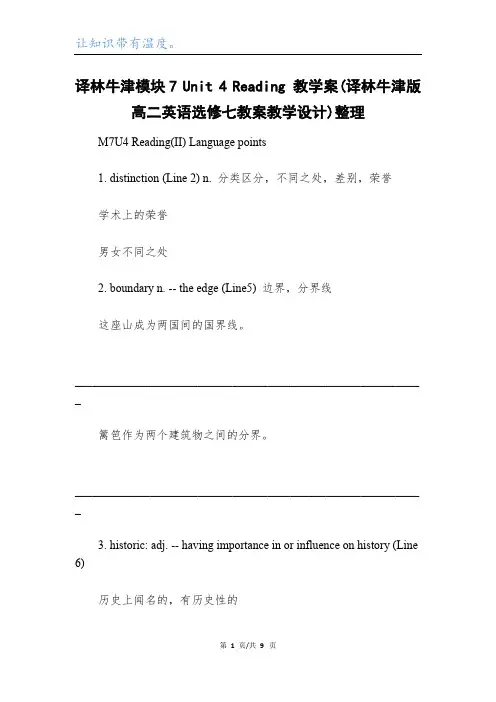
译林牛津模块7 Unit 4 Reading 教学案(译林牛津版高二英语选修七教案教学设计)整理M7U4 Reading(II) Language points1. distinction (Line 2) n. 分类区分,不同之处,差别,荣誉学术上的荣誉男女不同之处2. boundary n. -- the edge (Line5) 边界,分界线这座山成为两国间的国界线。
___________________________________________________________ _篱笆作为两个建筑物之间的分界。
___________________________________________________________ _3. historic: adj. -- having importance in or influence on history (Line 6)历史上闻名的,有历史性的1918年是具历史性的一天,由于它代表一战的结束。
___________________________________________________________ _你能告知我两位宏大领导之间的历史性会议是什么时候进行的?___________________________________________________________ _4. choke (Line8) v. 窒息;堵塞;堵塞choke off 中止,放弃;批判,责怪,训斥卡罗尔未经允许就借了汽车被他的父亲斥责了一顿。
___________________________________________________________ _引申: chock back 忍住,抑制choke down 硬咽,压制chock up 哽咽,因感动而未做好;堵塞,布满,长满During the rush hours the roads are usually _____ up with traffic.A. chockedB. crowdedC. blockedD. checked5. link up (Line21): to form a connection, especially in order to work or operate together: 联系,连接两条大路在这里连接起来。
高中英语unit4publictransport-project教案(牛津译林版选修7)

高中英语:unit4public transport-project教案(牛津译林版选修7)牛津选修七Unit4之Project Preventing accidents教学设计Teaching aims1) make the student aware of traffic accidents and preventing from traffic accident.2) Present their an action planTeaching methods1) Reading to get the general idea2) Ask and answer3) WritingTeaching aids1) A tape recorder2) A computerProceduresStep 1 lead inShow the students pictures of traffic accidents and a video clip of propagandizing preventing traffic accident.Step 2 Fast readingAnswer the questions:1. Why was the notice release?2.What information has the passage given to you?Step 3 Detailed reading1. What are some of the causes of traffic accidents involving vehicles?2. What is the most common cause of accidents?3. Why must drivers be forbidden to use the mobile phones while driving?4. Should cyclists and pedestrians also need to be responsible for preventing accidents.5. How do accidents involving bicycles happen?6. What things should all pedestrians do?Sept 4 Discussion:1. If you are a driver, what should you do to prevent accidents?2. What cyclists should do in order to prevent accidents?3. What should pedestrians do so as to prevent accidents?Step 5 writingWrite an action plan about how people, especially young people, can protect themselves from traffic accidents.Step 6 language points1. tripleAdj. 三倍的He got triple wages for all his extra work.v. 成了原来的三倍The prices of apartments have tripled in the past ten years.He tripled his income in five years.2. arisevi. 产生;发生;出现Serious disagreements often arises between the couple.Soon after that, there arouse new problems whichseemed insoluble.vi. 站起来,起身He arose and walked to the door.3. apply1. 适用于The new rules of safe driving applies to everyone.2. 运用Scientific discoveries are often applied to industrial production methods.3. 申请He applied to be transferred to another department.She has applied for a post in that company.Sept 7 HomeworkWrite down the action plan and propagate it to others, especially students.。
牛津译林版高中英语选修七《Unit 4 Public transport》Project 教案 3
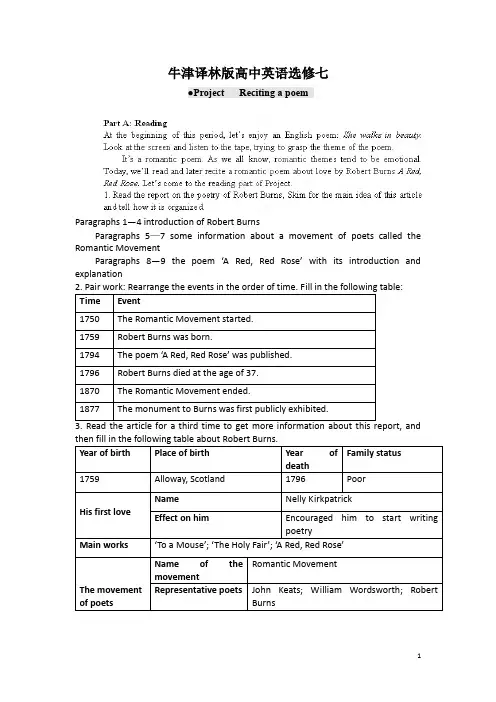
牛津译林版高中英语选修七●Project Reciting a poemParagraphs 1—4 introduction of Robert BurnsParagraphs 5—7 some information about a movement of poets called the Romantic MovementParagraphs 8—9 the poem ‘A Red, Red Rose’ with its introduction and explanationTime Event1750 The Romantic Movement started.1759 Robert Burns was born.1794 The poem ‘A Red, Red Rose’ was published.1796 Robert Burns died at the age of 37.1870 The Romantic Movement ended.1877 The monument to Burns was first publicly exhibited.and Year of birth Place of birth Year ofdeathFamily status 1759 Alloway, Scotland 1796 PoorHis first love Name Nelly KirkpatrickEffect on him Encouraged him to start writingpoetryMain works ‘To a Mouse’; ‘The Holy Fair’; ‘A Red, Red Rose’The movement of poets Name of themovementRomantic MovementRepresentative poets John Keats; William Wordsworth; RobertBurnsFeatures Romantic themes tend to be more emotional.The poems are always about love, dreams ornature.The way people memorize him *All of Scotland mourned his death, and afterwards many people donated money to support his widow and children. The monument to him was first publicly exhibited in 1877 and about 30,000 people attended the first exhibition.*The house in Alloway, where Burns was born, is now a museum of his life and work.meaning of the poem.Part B1. Group work: Discuss the eight questions in Part B. Then prepare your project.2. Present your project.Homework1. Read the passage in project and recite the poem.2. Do Parts B1 and B2 on page 101 of the Workbook.。
牛津译林版高中英语选修七《Unit 4 Public transport》Project 教案 2
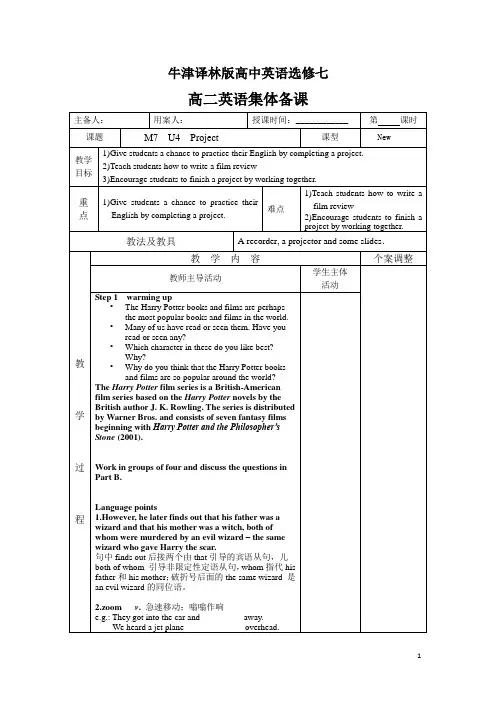
read sb.’s thoughts看出…的心思
pour out one’s thoughts倾诉自己的思想
5.J. K. Rowling, the author of the Harry Potter books, approved the final script of the film.
We heard a jet plane_____________overhead.
zoom back移后
3.I think this is more to show off the special effects than to help the film’s plot.
show off炫耀,卖弄
give thought to认真考虑,思考
e.g.:I will give thought to your orders.
collect one’s thoughts集中思想
distract sb.’s thought使某人分心
express thoughts表达思想
give up the thoughts of抛弃…的想法
句中finds out后接两个由that引导的宾语从句,儿both of whom引导非限定性定语从句,whom指代his father和his mother;破折号后面的the same wizard是an evil wizard的同位语。
2.zoomv.急速移动;嗡嗡作响
e.g.:They got into the car and_________away.
•Many of us have read or seen them. Have you read or seen any?
牛津译林版高中英语选修7复习教案模块七Unit 4 Public transport牛津译林版
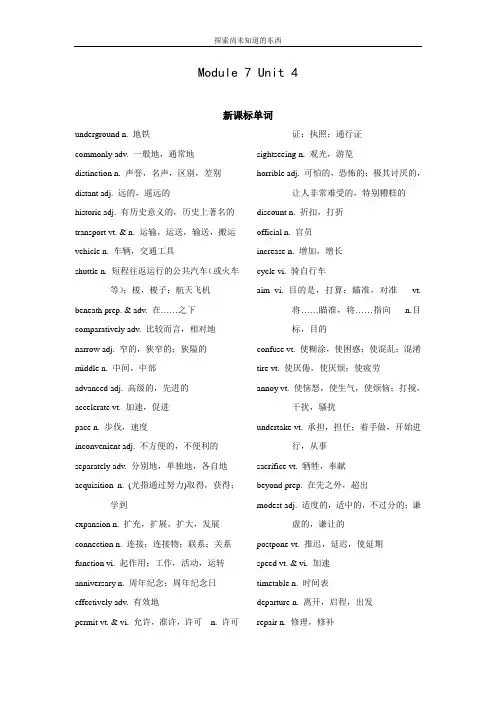
Module 7 Unit 4 新课标单词underground n. 地铁commonly adv. 一般地,通常地distinction n. 声誉,名声,区别,差别distant adj. 远的,遥远的historic adj. 有历史意义的,历史上著名的transport vt. & n. 运输,运送,输送,搬运vehicle n. 车辆,交通工具shuttle n. 短程往返运行的公共汽车(或火车等);梭,梭子;航天飞机beneath prep. & adv. 在……之下comparatively adv. 比较而言,相对地narrow adj. 窄的,狭窄的;狭隘的middle n. 中间,中部advanced adj. 高级的,先进的accelerate vt. 加速,促进pace n. 步伐,速度inconvenient adj. 不方便的,不便利的separately adv. 分别地,单独地,各自地acquisition n. (尤指通过努力)取得,获得;学到expansion n. 扩充,扩展,扩大,发展connection n. 连接;连接物;联系;关系function vi. 起作用;工作,活动,运转anniversary n. 周年纪念;周年纪念日effectively adv. 有效地permit vt. & vi. 允许,准许,许可n. 许可证;执照;通行证sightseeing n. 观光,游览horrible adj. 可怕的,恐怖的;极其讨厌的,让人非常难受的,特别糟糕的discount n. 折扣,打折official n. 官员increase n. 增加,增长cycle vi. 骑自行车aim vi. 目的是,打算;瞄准,对准vt.将……瞄准,将……指向n.目标,目的confuse vt. 使糊涂,使困惑;使混乱;混淆tire vt. 使厌倦,使厌烦;使疲劳annoy vt. 使恼怒,使生气,使烦恼;打搅,干扰,骚扰undertake vt. 承担,担任;着手做,开始进行,从事sacrifice vt. 牺牲,奉献beyond prep. 在先之外,超出modest adj. 适度的,适中的,不过分的;谦虚的,谦让的postpone vt. 推迟,延迟,使延期speed vt. & vi. 加速timetable n. 时间表departure n. 离开,启程,出发repair n. 修理,修补punctual adj. 准时的,准点的;守时的reliable adj. 可靠的,可信赖的arise vi. 发生,产生,形成;起立,起身;起床;起义extreme adj. 极端的,极度的cause n. 原因,起因;事业pedestrian n. 行人,步行者lorry n. 卡车surrounding adj. 周围的;环绕的n. 周围环境signal vi. 发信号impatient adj. 不耐烦的,没耐心的,急不可耐的aggressive adj. 好斗的,侵略性的,咄咄逼人的fine vt. 罚……的款,处……以罚金n. 罚金,罚款concentration n. 专心,专注;集中irresponsible adj. 不负责任的assumption n. 假定,臆想overload vt. 使超载,使过载unsteady adj. 不稳定的,摇摆的,摇晃invitation n. 诱因;邀请;请帖incorrectly adv. 不正确地,错误地orderly adj. 有秩序的,秩序井然的,有条理的课文出现短语1. pick up2. cause damage to3. beneath the surface4. far from5. in use6. why not do7. go sightseeing8. in the hope of9. speed up10. under repair11. protect sb from danger12. pay attention to13. risk your life14. avoid causing accidents 15. a couple of16. drop off17. choke off traffic18. link up19. set up20. function as21. permit sb to do22. at a discount23. make better use of24. wash away25. arise from26. be aimed at27. lead to crashes28. watch out for29. in need of30. be up to sb31. as it is known32. lead to33. accelerate the pace34. be responsible for35. in honor for36. a place of interest 37. be made up of38. make up for39. cause deaths and injuries40. traffic jam41. be aware of42. be fined for43. be likely to44. in good condition一.单词应用根据单词的首字母或汉语意思填写正确单词,注意形式变化。
牛津译林版选修七Unit4教案
Module7 Unit4 Public TransportThe first underground in the worldReadingⅠ一、学情分析1.教学对象为高二年级学生。
高二年级学生经过一年多的高中英语学习,已经具备了一点语言功底,部分学生能较为自如地表达自己对一些事物的观点,班上同学间的合作学习也有了些发展。
2.本节课的话题是The first underground in the world(世界上第一条地铁),这是关于Public transport(公共交通)的问题,更是全球都关注的话题,城市里的学生每天上学回家都有可能遭遇到交通堵塞,尤其上下班高峰期、节假日出行都非常困难,在教学中渗透文明出行、出行安全等情感教育。
二、教材分析本节课是阅读教学的第一课时,该部分是一篇介绍世界上第一条地铁——伦敦地铁发展历史的旅游宣传手册(brochure)。
通过对这部分的学习,要求学生对伦敦铁路建造的历史发展过程有深刻的理解,同时也要求学生掌握旅游宣传手册阅读策略的技巧。
由于本课课文具有段落多、课文篇幅长、生词多、逻辑性较强等特点,本节课的教学难点就放在帮助学生理解和掌握课文内容,通过预测及归纳各段落中心思想来构建文本的整体框架;然后再运用skimming & scanning等技巧完成问答、填写表格、填词等练习,以加深对文本的理解,并掌握旅游手册的阅读策略。
最后,让学生通过巩固练习、讨论活动和写作等方式来运用所学内容、加深对该话题的理解。
三、设计思路1.本堂课采用任务型教学途径,因为淮安市为旅游城市,而阅读策略又是阅读旅游手册,因此从旅游话题切入文章。
既训练说的能力,更为了提高对身边事、社会事的关注与思考。
2.由于课文偏长,在引导学生阅读时,尽可能设计一些紧扣课文内容的练习形式,辅助他们比较轻松地抓住要点信息,如填空题、列时间表填空题、单项选择题、简单的答问题等。
13.考虑到学生的学情,充分保护他们的积极性和热情是十分重要的。
模块七unit4Reading教案(译林牛津版高二英语选修七教案教学设计)
模块七 unit 4 Reading 教案(译林牛津版高二英语选修七教案教学设计)Period 2Teaching aim:To help the students to understand the textTo learn the reading strategyTo learn the vocabulary about the textTeaching important point:How to develop the reading ability of studentsHow to get the general idea of the textTeaching difficult point:How to grasp the skills of learn a brochureTeaching methodsReading explanationTeaching aid:computerTeaching procedures:Step 1 GreetingsGreat the class as usualStep 2. RevisionReview the language point in welcome to the unitStep 3 Lead-inZhao Ning went on a trip to London . she collected a brochure about th e Underground. We will find the history of its development and the important people who influenced the London Underground. Next, we will learn the brochure and deal with the questions.Step 4. Fast-readingQuestions1. When was the first underground system opened?2. Why was the Victoria Line important?3. What did Charles Holden do?Suggested answers1. In 1863.2. It was important because it linked with other lines at almost station , making the system more user-friendly.3. He is the architect that designed many of the new stations built between 1918 and 1938. Many of the stations are still in use today.Step 5. careful-readingAsk the students to read the passage again and finish C1 and C2 and part D.C1.Questions1. Why was an underground system first developed in London?2. What was the London Underground like in 1863?3. What did Charles Yerkes do to improve the underground?4. What are some of the different things that the underground has functioned as?5. what happened to the London Underground after World War Ⅱ?6. What does it mean when the brochure says that the underground system is user-friendly?Answers1. Most railway tracks did not go into the London city centre, so buses were required . This increased traffic on the road. The underground system transported more people without increasing traffic on the road.2. The carriages did not have windows and were pulled by steam engines through narrow tunnels.3. He bought many of the different lines and set up the Underground Groups.4. The underground has functioned as a bomb shelter, an aeroplane factory, an anti-aircraft centre and meeting rooms for the government administration.5. After World War Ⅱ, more lines were added because more people traveled on the underground.6. It means that many of the lines are linked at many stations .Therefore , it is very convenient for ridersTo go to different places in the city from any station.C 2Date Event185418631868188419331918--1938After 19451977Answers:1. An underground railway was decided to be built.2. The first tunnels were opened.3. The next section of the underground system was opened.4. The underground service was provided in the middle of the city.5. A public organization was created.6. London Transport was expanded.7. More people traveled on the underground and more lines were added.Step 6 practiceFinish part D on page 52Keys1 .d . 2. e. 3. b. 4.f. 5.c. 6.h. 7.g. 8.a.Step 7 summary and homeworkPeriod 3Teaching aim:To help the students to master some important words and phrasesTeaching important pointDistant transport link to accelerate functionTeaching difficult point:How to help the students to master these important language pointsTeaching methodsReading explanationTeaching aid:computerTeaching procedures:Step 1 GreetingsGreet the whole class as usual.Step 2 RevisionAsk some students to speak out the form of a debateStep 3 ExplanationIn this class , we will deal with the language points in reading, Listen carefully and write them in your notebook..1. distinction 声誉,声望,区别,级别eg I don’t understan d your distinction: surely all painting isart?draw/make a distinction between 对…… 加以区别gain/win distinction 出名win a distinction for 因… … 而获功勋with distinction 以优异的成绩,以杰出的表现without distinction 无差别的,一视同仁地2 . distant [adj] 遥远的,冷淡的,疏远的,不易见的be distant toward sb. 对某人冷淡in the distance 在远处at a distance 相距,相隔,稍远处from a distance 从一定距离keep sb at a distance =keep one’s distance from与… … 保持一定的距离e.g 1. At a distance of six miles you can’t see much.2. We can see the ancient ruins in the distance.3.You can see the picture clearly if you stand at a distance.PracticeThe dog looked dangerous , so I decided to keep my distance from it .The faces of four famous American presidents on Mount Rushmore can be seen from a _______of 60 miles.A. lengthB. distanceC. wayD. space3 transporttransport sth from … to …the transport of goods by airin transports of delightEg1.A bus transported us from the airport to the city.2. The transport of goods by air costs a lot.PracticeThe cars ________to the far-off countries by ship.A. have transportedB. are transportingC. are transportedD. transport4. accelerate 加速,促进。
牛津英语模块七第四单元Project教案1
Project Preventing traffic accidentsStep 1: lead-in.T: What do the two pictures above tell us?S: Terrible accidents happened.T: Every day we go to school and come back home by bus, by bike or on foot. We should know how to protect ourselves from the road accidents. Today we will learn a passage which tells us something about the traffic accidents and road safety.First, let’s discuss the following questions:1. What should you pay attention to when you go to school by bike?2. What do you need to do to avoid accidents on your way to school on foot?3. If you are a bus driver, what do you think you should or shouldn’t do when you drive students to their school?4. What are the possible reasons for the traffic accident? What do you think should be done to avoid a traffic accident?Discuss them in your groups and write your group answers down, then report them to the class.Step 2: Part A1. ReadingNow we are going to read an article entitled Traffic Accidents and Road Safety. From the title, what information do you think the reading passage will give us? (It will mainly talk about two things: the causes of traffic accidents and how to be safe on the road.)Answers1 Traffic accidents involving vehicles are mainly caused by drivers who make incorrect actions, such as not paying attention while driving, being impatient in a traffic jam, speaking on a mobile phone while driving, drinking alcohol, speeding and so on.2 Accidents involving bicycles are usually caused because cyclists are not paying attention to the cars around them, or carrying a passenger. Sometimes accidents occur with bicycles when the brakes on their bicycles do not work properly or their bicycles do not use lights at night.3 There should be a light on the bicycle.4 Pedestrians should always cross roads on a crossing. While crossing, they should look both ways and listen for cars.1) What is the purpose of the notice?________________________________________________________________________ 2)What is the most common cause of accidents?________________________________________________________________________ 3) Why is it dangerous for drivers to speak on mobile phones?________________________________________________________________________4) Can cyclists ride on the pavement? Why (not)?________________________________________________________________________ 5) What can we do to prevent accidents?The notice was released because ____________. (the number of accidents and the deaths arising from traffic accidents has increased greatly over the past year)In order to prevent accidents, drivers should_____________________________________;( pay attention to the surrounding traffic)_____________________________________; (be patient in a traffic jam)_____________________________________; (not speak on a mobile phone)_____________________________________; (not drink alcohol)_____________________________________; (not drive too fast)In order to prevent accidents, cyclists should_____________________________________; (always obey traffic laws)_____________________________________; (pay attention to the cars that surround them)_____________________________________; (not carry a passenger)_____________________________________; (have a light on the bicycle at night)_____________________________________; (keep the bicycle in good condition) In order to prevent accidents, pedestrians should_____________________________________; (always cross roads on a crossing)_____________________________________; (look both ways and listen for cars while crossingthe street)_____________________________________; (never ignore traffic lights)Step 3: Part BWork in groups of four or six to discuss the questions 5-8 in Part B. Write down your answers. Then one student from each group presents your answers to the class. Other groups can give your comments.Step 4: Exercises:Complete the sentences with proper words or phrases from the article on pages 62-63 of your book. Change the form where necessary.1) There were 39, 000 new cases last year - an ____________ of 7 per cent.2) He is still standing under the tree, not ____________ the danger.3) My father was ____________ for dangerous driving yesterday.4) He has been ____________ from his job for dishonesty.5) It would be____________ to ignore these warnings.6) Leaving your house unlocked is an open ____________ to burglars7) The western part of China is in great ____________ of teachers.8) Whenever you come into his room, it is always ____________.9) I found it hard to follow what the teacher was saying, and eventually I lost ____________.10) In ____________ cases, the disease can lead to blindness.Step 5: Homework:1. Finish D1 and D2 on page 129 of the Workbook.2. Read the newspaper article in Part B on page 131 of the Workbook to know about an aeroplane accident many years ago.。
牛津译林版高中英语选修七Unit 4《Public transport》(Project)教学设计
牛津译林版高中英语选修七Unit 4《Public transport》(Project)教学设计单元:Unit 4 Public transport板块:ProjectThoughts on the design:Project(项目学习)的依照宗旨是Learn by doing“做中学”。
通过阅读课本所提供的素材,使学生了解有关交通事故起因以及如何幸免交通事故的措施,为写作做预备。
写作由小组合作完成,组长明确每个成员的工作,教师提供适当的写作辅导,并鼓舞各组将自己认为专门的体会加入到写作中,最后各组由一名成员展现成果,稍加评点。
Teaching aims:After this period learning, the students will be able to:1.learn how to protect themselves from dangers on the roads;2.write an action plan.Teaching procedures:Step 1 Lead-in1.Show some pictures of traffic accidents and get students to know some statistics.(PPT 4-5)➢How many people die in crashes on the world's roads every year?(1.3 million dead; a further 50 million injured)➢In China, in 2009, how many people died in traffic accidents and how many got wounded? (67,759 dead; 275,125 wounded)➢In the first half of 2010, how many people were killed and how many injured?(27,270 dead; 116,982 injured)2.Watch a video clip and think what caused the traffic accident. (drunk driving)(PPT 6)3.Show some pictures of senses of traffic accidents to show that besides drivers,cyclist s and pedestrians also are responsible for road accidents. Therefore, we all should raise our awareness of road safety. (PPT 7)Step2 Reading1.Read the passage and answer some questions. (PPT 8-9)1)For what purpose is the notice written? Why?2)What are some major causes of road accidents related to drivers, cyclistsand pedestrians?Encourage students to find more causes of accidents.2.Read again and complete the following notes: (PPT 10-13)In order to prevent accidents,drivers should …cyclists should …pedestrians should …Encourage students to find more ways to avoid accidents.Step 3 Writing an ac tion plan1.Planning (PPT 14 +Worksheet)1)Divide students into groups of 4, assigning one of them group leader.2)The leader assigns different jobs to each member.2.Brainstorming (PPT 15+Worksheet)1)Discuss what students could do to help prevent traffic accidents. Enco uragestudents to find new ideas.2)Show students how certain sentence patterns to put these items into theiraction plan.3)Tick the items which can be included in the action plan.3.Writing (PPT 16 +Worksheet)1)Give a brief guide how to arrange this action plan. Give some expressionsif needed.2)Write the action plan on the worksheet.3)Have it proofread.4.PresentingOne mem ber of each group presents their action plan in class. Others make brief comments and choose which one is the best.[Explanation]写作由“brainstorming”开始,指导学生用课文材料中的素材用于写作,并鼓舞学生依照自己的体会增加idea。
- 1、下载文档前请自行甄别文档内容的完整性,平台不提供额外的编辑、内容补充、找答案等附加服务。
- 2、"仅部分预览"的文档,不可在线预览部分如存在完整性等问题,可反馈申请退款(可完整预览的文档不适用该条件!)。
- 3、如文档侵犯您的权益,请联系客服反馈,我们会尽快为您处理(人工客服工作时间:9:00-18:30)。
模块七第四单元Project教案Project Preventing traffic accidentsStep 1: lead-in.T: What do the two pictures above tell us?S: Terrible accidents happened.T: Every day we go to school and come back home by bus, by bike or on foot. We should know how to protect ourselves from the road accidents. Today we will learn a passage which tells us something about the traffic accidents and road safety.First, let’s discuss the following questions:1. What should you pay attention to when you go to school by bike?2. What do you need to do to avoid accidents on your way to school on foot?3. If you are a bus driver, what do you think you should or shouldn’t do when you drive students to their school?4. What are the possible reasons for the traffic accident? What do you think should be done to avoid a traffic accident?Discuss them in your groups and write your group answers down, then report them to the class.Step 2: Part A1. ReadingNow we are going to read an article entitled Traffic Accidents and Road Safety. From the title, what information do you think the reading passage will give us? (It will mainly talk about two things: the causes of traffic accidents and how to be safe on the road.)Now read the article carefully and find answers to first four questions in Part B.2. Let’s check your understanding of the reading passage by more questions.1) What is the purpose of the notice?__________________________________________________________________ ______2)What is the most common cause of accidents?__________________________________________________________________ ______3) Why is it dangerous for drivers to speak on mobile phones?______________________________________________________________________ __4) Can cyclists ride on the pavement? Why (not)?__________________________________________________________________ ______5) What can we do to prevent accidents?__________________________________________________________________ _____3. Read the article again and complete the following notes:The notice was released because ____________. (the number of accidents and the deaths arising from traffic accidents has increased greatly over the past year)In order to prevent accidents, drivers should_____________________________________;( pay attention to the surrounding traffic)_____________________________________; (be patient in a traffic jam)_____________________________________; (not speak on a mobile phone)_____________________________________; (not drink alcohol)_____________________________________; (not drive too fast)In order to prevent accidents, cyclists should_____________________________________; (always obey traffic laws)_____________________________________; (pay attention to the cars that surround them)_____________________________________; (not carry a passenger)_____________________________________; (have a light on the bicycle at night)_____________________________________; (keep the bicycle in good condition)In order to prevent accidents, pedestrians should_____________________________________; (always cross roads on a crossing)_____________________________________; (look both ways and listen for cars while crossing the street)_____________________________________; (never ignore traffic lights)Step 3: Part BWork in groups of four or six to discuss the questions 5-8 in Part B. Write down your answers. Then one student from each group presents your answers to the class. Other groups can give your comments.Step 4: Exercises:Complete the sentences with proper words or phrases from the article on pages 62-63 of your book. Change the form where necessary.1) There were 39, 000 new cases last year - an ____________ of 7 per cent.2) He is still standing under the tree, not ____________ the danger.3) My father was ____________ for dangerous driving yesterday.4) He has been ____________ from his job for dishonesty.5) It would be____________ to ignore these warnings.6) Leaving your house unlocked is an open ____________ to burglars7) The western part of China is in great ____________ of teachers.8) Whenever you come into his room, it is always ____________.9) I found it hard to follow what the teacher was saying, and eventually I lost ____________.10) In ____________ cases, the disease can lead to blindness.Step 5: Homework:1. Finish D1 and D2 on page 129 of the Workbook.2. Read the newspaper article in Part B on page 131 of the Workbook to know about an aeroplane accident many years ago.。
